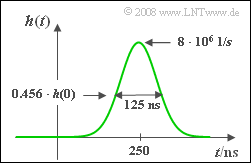Difference between revisions of "Aufgaben:Exercise 1.7: Nearly Causal Gaussian Low-Pass Filter"
| Line 28: | Line 28: | ||
*Reference is made especially to the page [[Linear_and_Time_Invariant_Systems/Some_Low-Pass_Functions_in_Systems_Theory#Gaussian_low-pass_filter|Gaussian low-pass filter]]. | *Reference is made especially to the page [[Linear_and_Time_Invariant_Systems/Some_Low-Pass_Functions_in_Systems_Theory#Gaussian_low-pass_filter|Gaussian low-pass filter]]. | ||
| − | * | + | *You can use the Gaussian (error) integral to calculate step and rectangle responses: |
:$${\rm \phi}(x) = \frac{1}{\sqrt{2 \pi }} \cdot | :$${\rm \phi}(x) = \frac{1}{\sqrt{2 \pi }} \cdot | ||
\int_{ -\infty }^{ x } {{\rm e}^{-u^2/2}} \hspace{0.1cm}{\rm d}u.$$ | \int_{ -\infty }^{ x } {{\rm e}^{-u^2/2}} \hspace{0.1cm}{\rm d}u.$$ | ||
| − | [[File:P_ID864__LZI_A_1_7b.png |center|frame| | + | [[File:P_ID864__LZI_A_1_7b.png |center|frame|Some values of the Gaussian error function]] |
| Line 38: | Line 38: | ||
| − | === | + | ===Questions=== |
<quiz display=simple> | <quiz display=simple> | ||
| − | { | + | {What is the equivalent bandwidth $\Delta f $ and the runtime $\tau $? |
|type="{}"} | |type="{}"} | ||
$\Delta f \ = \ $ { 8 3% } $\ \rm MHz$ | $\Delta f \ = \ $ { 8 3% } $\ \rm MHz$ | ||
| Line 47: | Line 47: | ||
| − | { | + | {It holds that $x(t) = 1 \hspace{0.05cm}{\rm V} · \cos(2π · 6\ {\rm MHz }· t)$. What is the output signal $y(t)$? What is the signal value at time $t = 0$? |
|type="{}"} | |type="{}"} | ||
$y(t = 0) \ = \ $ { -0.175--0.165 } $\ \rm V$ | $y(t = 0) \ = \ $ { -0.175--0.165 } $\ \rm V$ | ||
| Line 64: | Line 64: | ||
</quiz> | </quiz> | ||
| − | === | + | ===Solution=== |
{{ML-Kopf}} | {{ML-Kopf}} | ||
'''(1)''' Die äquivalente Bandbreite $Δf$ ist gleich $h(t = τ) \hspace{0.05cm} \rm \underline{= \ 8 \ MHz}$. | '''(1)''' Die äquivalente Bandbreite $Δf$ ist gleich $h(t = τ) \hspace{0.05cm} \rm \underline{= \ 8 \ MHz}$. | ||
Revision as of 12:18, 8 September 2021
Measurements have shown that an LTI–system can be well approximated by a Gaussian low-pass filter if an additional runtime $τ$ is taken into account. Thus, the frequency response is:
- $$H(f) = {\rm e}^{-\pi\hspace{0.05cm}\cdot \hspace{0.05cm}(f/\Delta f)^2} \cdot {\rm e}^{-{\rm j}\hspace{0.05cm}\cdot \hspace{0.05cm}2\pi f \tau}.$$
The two system parameters,
- the equivalent duration of the impulse $Δt = 1/Δf$ and
- the delay time $τ$,
can be taken from the impulse response $h(t)$ shown in the graph.
- It is obvious that this model does not correspond exactly to the (causal) reality since the impulse response $h(t)$ does not completely vanish even for $t < 0$ .
- Therefore, in subtask (3) the maximum relative error is aked for and defined as follows:
- $$\varepsilon_{\rm max} = \frac{\max_{t \hspace{0.02cm}< \hspace{0.1cm}0}|h(t)|}{h(t = \tau)}.$$
In words: The maximum relative error $ε_{\rm max}$ is equal to the maximum value of the impulse response $h(t)$ at negative times with respect to the maximum value $h(t = τ)$ of the impulse response.
Please note:
- The exercise belongs to the chapter Some Low-Pass Functions in Systems Theory.
- Reference is made especially to the page Gaussian low-pass filter.
- You can use the Gaussian (error) integral to calculate step and rectangle responses:
- $${\rm \phi}(x) = \frac{1}{\sqrt{2 \pi }} \cdot \int_{ -\infty }^{ x } {{\rm e}^{-u^2/2}} \hspace{0.1cm}{\rm d}u.$$
Questions
Solution
- Dies ist gleichzeitig der Kehrwert der äquivalenten Impulsdauer $Δt = 125 \ \rm ns$.
- Auch die Phasenlaufzeit $τ \hspace{0.15cm} \rm \underline{= \ 250 \ \rm ns}$ kann direkt aus der Grafik abgelesen werden.
(2) Ohne Berücksichtigung der Laufzeit ergäbe sich ein Cosinussignal mit der Amplitude
- $$A_y = 1\,{\rm V} \cdot {\rm e}^{-\pi({ {6\,\rm MHz} }/{ {8\,\rm MHz} })^2}= 0.171\,{\rm V}.$$
- Die Laufzeit bewirkt eine Phasenverschiebung um $3π$:
- $$ y(t) = A_y \cdot {\rm cos}(2\pi f_0 ( t - \tau) ) = A_y \cdot {\rm cos}(2\pi f_0 t - 2\pi \cdot {6\,\rm MHz}\cdot {250\,\rm ns} ) = A_y \cdot {\rm cos}(2\pi f_0 t - 3\pi ) = -A_y \cdot {\rm cos}(2\pi f_0 t ).$$
- Der gesuchte Wert ist somit $y(t = 0) \hspace{0.05cm} \rm \underline{= \ –0.171 \ V}$.
(3) Die Impulsantwort lautet:
- $$h(t) = h_{\rm GTP}(t - \tau) =\Delta f \cdot {\rm e}^{-\pi(\frac{t - \tau}{\Delta t})^2} .$$
- Da $h(t)$ im Bereich $t < 0$ stetig zunimmt, tritt der Maximalwert (bei negativen Zeiten) etwa bei $t = 0$ auf:
- $$h(t = 0) = \Delta f \cdot {\rm e}^{-\pi(\frac{ \tau}{\Delta t})^2}= \Delta f \cdot {\rm e}^{-4\pi} .$$
- Mit $h(t = τ) = Δf$ erhält man so:
- $$\varepsilon_{\rm max}= {\rm e}^{-4\pi}\hspace{0.15cm}\underline{ \approx 3.49} \cdot 10^{-6} .$$
(4) Wir lassen vorerst die Phasenlaufzeit $τ$ des zweiten Systems außer Betracht und berechnen die Sprungantwort des Gaußtiefpasses:
- $$\sigma_{\rm GTP}(t) = \frac{1}{\Delta t} \cdot \int_{ -\infty }^{ t } {{\rm e}^{-\pi \left({t\hspace{0.05cm}'}/{\Delta t}\right)^2}} \hspace{0.1cm}{\rm d}t'.$$
- Nach der Substitution $u = t\hspace{0.05cm}' \cdot {\sqrt{2\pi}}/{\Delta t}$ ergibt sich mit dem Gaußschen Fehlerintegral $ϕ(x)$:
- $$\sigma_{\rm GTP}(t) = \frac{1}{\sqrt{2 \pi } } \cdot \int_{ -\infty }^{ \sqrt{2\pi}\cdot\hspace{0.05cm} t / \Delta t } { {\rm e}^{-u^2/2} } \hspace{0.1cm}{\rm d}u = {\rm \phi}(\sqrt{2\pi}\cdot \frac{t}{\Delta t }),\hspace{1cm} {\rm \phi}(x) = \frac{1}{\sqrt{2 \pi }} \cdot \int_{ -\infty }^{ x } {{\rm e}^{-u^2/2}} \hspace{0.1cm}{\rm d}u.$$
- Unter Berücksichtigung der Laufzeit $τ$ erhält man somit für die gesamte Sprungantwort:
- $$\sigma(t) = \sigma_{\rm GTP}(t - \tau) = {\rm \phi}(\sqrt{2\pi}\cdot \frac{t - \tau}{\Delta t }).$$
- Der Wert bei $t = τ = 250 \ \rm ns$ ist
- $$\sigma(t = {250\,\rm ns}) = \sigma_{\rm GTP}(t = 0) =\ \rm \underline{ϕ(0) \ = \ 0.500}.$$
- Entsprechend erhält man für $t = τ = 300 \ \rm ns$:
- $$\sigma(t = {300\,\rm ns}) = \sigma_{\rm GTP}(t = {50\,\rm ns}) = {\rm \phi}(\sqrt{2\pi}\cdot \frac{ {50\,\rm ns} }{ {125\,\rm ns} })\approx {\rm \phi}(1)\hspace{0.15cm}\underline{ = 0.841}.$$

